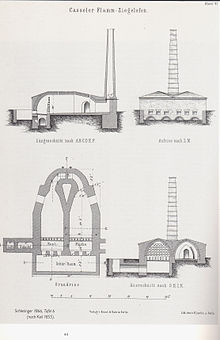Old Röbel / Müritz brickworks
The old brickworks in Röbel an der Müritz is an industrial monument . It is located on the route of the Mecklenburg Lakes Cycle Path not far from the Müritz National Park .
history
18th century
In May 1724 over 120 houses were destroyed in the great fire in Röbel. Bricks were needed; Thatched roofs were no longer allowed to be built; So the council of the arable town decided to build a brick factory on the outskirts. The brick kiln was built in 1724 in the style of the old German chamber kiln , as was a drying shed and a horse peg . In Gosenow (today's name: Gausmoor) clay was mined and transported to the brickworks. In the Göpel this was crushed, compacted and placed in wooden brick molds. Initially, the city employed the master bricklayer Groth (grandfather of the later owner) from Kambs and several day laborers .
19th century
The master bricklayer Wilhelm Groth (* 1815) auctioned the lease for the brickworks and the Gosenow in November 1844 at an annual price of 570 thalers. In 1845 this was confirmed with the lease deed from Friedrich Franz II .
After Wilhelm Groth's marriage to Luise Friederike from Marwitz on June 20, 1845, the lease agreement was converted into a purchase agreement on July 14, 1845; Groth became the owner of the brickworks. The Grand Duke as feudal lord and the Röbel city treasury confirmed the purchase. After the birth of his daughter Elisa-Friederike in 1846 and his son Wilhelm-Friedrich in 1847, Wilhelm Groth built the first house on the property. In 1856 the brickworks was expanded with an industrial brick kiln (Casseler brick flame kiln, patented in 1827 by Ing. Carl Anton Henschel from Kassel) and a drying shed. The bricks were stored in the drying shed to dry out and then placed in the Kassel oven. The brickworks flourished and many of the surrounding villages, churches and individual farmhouses were supplied. Sometimes the brickworks employed up to 30 day laborers. In 1858 the house was completely rebuilt for the now large family and thus achieved its present state. At that time there was also a large stable building, which now houses holiday apartments, as well as a barn, of which the foundation walls have been preserved, and a carriage house for horses and carriages, which has since been demolished. In 1874 the first owner Wilhelm Groth died and handed over the "Ziegelei Groth" to his sons Wilhelm-Friedrich (* 1847), Hermann-Albert (* 1849) and Rudolf-Karl (* 1855). Wilhelm-Friedrich and Hermann-Albert also became master bricklayers and continued to run the brickworks. In 1891 the master bricklayer Hermann-Albert married Roselte Peters (* 1870). This marriage resulted in 4 children (Helene * 1892, Elisa * 1894, Annemarie * 1899 and Hermann * 1902). In 1925 Wilhelm-Friedrich died unmarried.
20th century
In 1916 the "Ziegelei Groth" was shut down. The reasons for this were constant flooding of the clay pits in Gosenow, a labor shortage as a result of the First World War , rapidly increasing wood prices and difficult wood procurement. In 1928 the master bricklayer Hermann-Albert Groth died and his son Hermann Groth (* 1902) took over the brickworks. The district commissioner for the state of Mecklenburg in Schwerin applied for the city of Röbel to put the owner Hermann Groth's brickworks back into operation. After clarifying various points (financing, wood procurement, etc.) between the owner Hermann Groth, the Mecklenburg State Ministry and the city of Röbel, the Groth'sche brickworks went back into operation in 1937. An application in 1943 by the Reich Minister for Armaments and Ammunition Albert Speer via the Mecklenburg District Administrator to relocate important Air Force equipment to the "Alte Ziegelei" was unsuccessful because it was in operation again in the meantime.
After 1945
In 1945, the Soviet occupying forces showed interest in the brickworks as it was an industrial facility. She arranged the forced relocation of the owner Hermann Groth with his sisters Helene and Annemarie Groth to a small apartment in Röbel. Hermann Groth had manipulated the forge of the Kassel stove so that it collapsed when the occupiers tried to start the first fire. Hermann Groth and his two sisters were able to return to the "old brickworks".
In 1982 the last direct descendant of the Ziegler family, Hermann Groth, died. The "Ziegelei Groth" was now an empty ensemble of buildings and fell into disrepair. In 1983 Bernd and Inge Lange from Rostock bought the property for their daughter Christine. In the following years several collapsed buildings were demolished (shed, coach house, drying shed). The daughter of the Lange couple, Christine Gumpert, and her family could no longer realize the dream of a farm on the "old brickworks" because there was no more arable land. Hermann Groth had to cede this to LPG in order to keep the brickworks . From 1994 the house of the old brickworks was renovated and now serves as a studio and guesthouse. The ensemble was placed under monument protection.
Web links
Individual evidence
- ↑ List of the Mecklenburg-Western Pomerania State Parliament, page 201 . List of monuments for Mecklenburg / Western Pomerania, status 1997. Accessed on February 8, 2015.
- ↑ 750 years of Röbel - time table . Website of the city of Röbel / Müritz. Retrieved December 29, 2014.
Coordinates: 53 ° 21 ′ 16 " N , 12 ° 38 ′ 35.3" E



